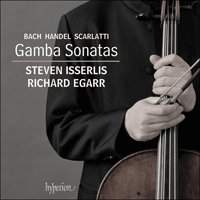Texte paru dans: / Appeared in: |
|
|
Outil de traduction ~ (Très approximatif) |
|
|
Reviewer: Bertil
van Boer The focal point for this disc is 1685, the birth year of Johann Sebastian Bach, George Frédéric Handel, and Domenico Scarlatti, but the purpose is to perform arrangements of the works by each of the composers for cello and continuo. Of these works, the three Bach sonatas were originally for viola da gamba, though there were probably other (and perhaps earlier) versions for various instruments. The Scarlatti was originally for violin and continuo, necessitating only a few adjustments, while the Handel was originally for oboe, though in his printed version he cribbed a bit by throwing in a clef change and an enigmatic comment that it might have been meant for the gamba. In short, nothing was meant for the cello (for which Bach at least write six iconic solo suites), and thus it seems more of a recorded recital than any real attempt to “reconstruct” original pieces. The arrangements seem rather straightforward, and therefore each of these works fits the instrument well. Of these, the three Bach gamba sonatas are probably the best suited to the adaptation. The G-Major work is wonderfully lively work in the fast movements, while the slow ones move along at a stately pace. They meander, and the use of effects such as the mezzo di voce of the opening can be emotionally effective. Here the cello is complemented nicely by the harpsichord. The G-Minor Sonata, however, has a more serious tone, and it is a sort of suite paraphrase that allows for the cello’s deeper tone to emerge. The harpsichord is not lazy, either, with a part that is quite orchestral in texture (the notion that this may have been itself adapted from a concerto grosso, however, is less convincing). The contrapuntal finale has some gnarly imitation that is one of Bach’s hallmarks. The final work, in D Major, begins with a soft, plaintive air that simply soars gracefully above a countermelody in the harpsichord. This in turn moves into a singing faster movement that has a lovely line that sequences out as is Bach’s wont. The minor key third movement is a lament, plaintive and sensitive, while the finale rocks right along. The other two works are perhaps less successful, though the opening of the Scarlatti adaptation has a nice duet between the solo and continuo cellos that sounds quite galant. The second movement sounds very Vivaldian, while the finale is a somber gigue. The opening Handel movement is quite aria-like, as if he was parodying one of his spun-out opera pieces. There is a sewing-machine intensity to the second, while the third movement is little more than a brief arioso with some nice duet playing with the continuo cello. The gigue is lively enough, almost a hornpipe.
The playing by cellist Steven
Isserlis is sonorous and technically proficient. The harpsichord continuo of
Richard Egarr is often more in the background than not, but when joined by
continuo cellist Robin Michel, the effect is suitably trio-like. Although
the performance practice is modern, all three handle these adaptations with
skill and ease, making this disc a pleasure to listen to. Each work will, of
course, have its originals done on period instruments, but for a nice hour
of soothing and flowing Baroque music, this one is nicely done.
| |
|
|
|
|
Cliquez l'un ou l'autre
bouton pour découvrir bien d'autres critiques de CD |
|




